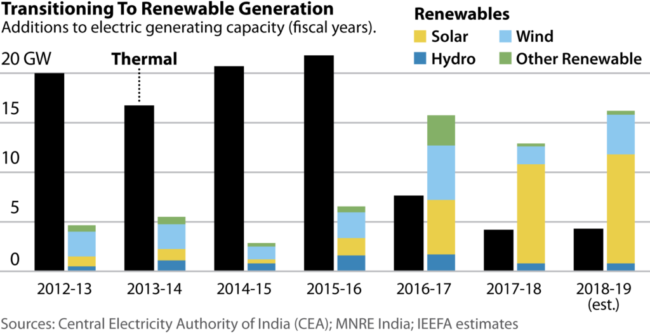To cheer you up from a news diet of Trump, a chart from IEEFA of new generating plants in India:

Coal fell off a cliff two years ago. The coal additions in 2017-18 (India uses an April-to-April fiscal year inherited from the Raj) were only 4.2 GW. Coal Plant Tracker still reports 39 GW of coal under construction (with 97 GW suspended and a staggering 476 GW cancelled since 2010), but it’s very likely that much of this is walking dead. IEEFA predicts the real pipeline is 10-20 GW, after which no more will (I infer) ever be needed.
You don’t often see turning points advertised in neon like this. India has had since 2003 a modern split electricity market as in the UK and Texas, with a monopoly national grid, monopoly state distribution companies, and competitive generation. So you got a coal bubble, and a coal crash – far more dramatic than in dirigiste China or quasi-socialist USA. It’s pretty certain that the owners of the few plants coming online are not happy bunnies, and their shiny new assets are born lossmakers. India has large surplus capacity (the power cuts come from the rickety grid), so the average coal capacity factor is below 60% and heading down. New solar can beat existing coal on price by 20%, so it’s only going to get worse.
Indian banks have up to $38 bn of bad loans to power companies (Merrill Lynch). Modi’s government is business-friendly to the point of cronyism, so some sort of bailout will be arranged. It is even more voting-farmer-friendly, so the bailout will not be perfect. Gautam Adani will remain a rich man, but not as rich as he is today.
The Times today reported that Britain has logged 1000 hours this year of zero coal use nationally. The total for all of last year was about half that.
As I understand it, the inherent fluctuations in solar generation put a lot of stress on grid management, as Germany has learned with the switch from nuclear to wind. I hope India is addressing that.
You reliably cheer me up, James. You are the one man who does that (besides rels). Thank you.